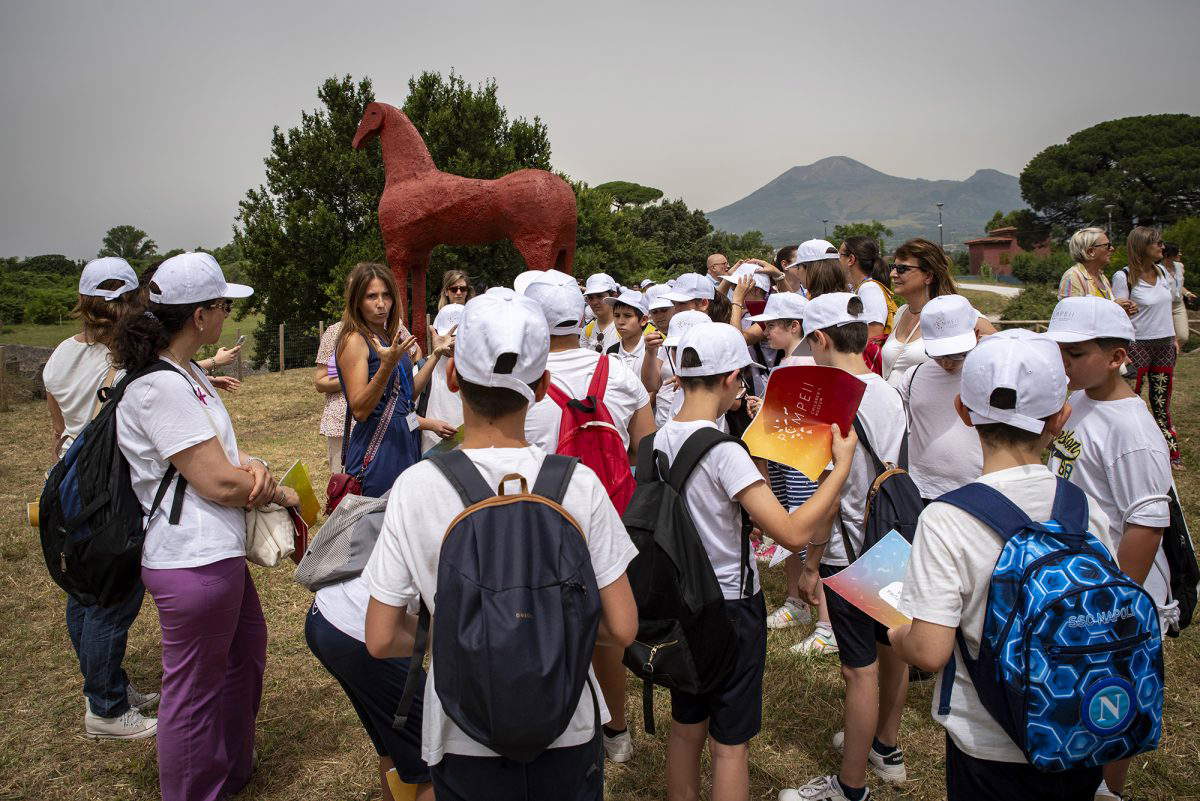Pompeii Children’s Museum, the first space dedicated to children and families within an archaeological area, is born in Pompeii: it will be inaugurated in 2025, with activities organized, however, as early as July 2024. Located in the Casina Rosellino, a 19th-century building in the Pompeii Archaeological Park, this innovative project is the result of a public-private partnership between the Pompeii Archaeological Park and the Aion Consortium (artem and Le Nuvole/theater art science) and Gruppo Pleiadi.This ambitious project is housed in the Casina Rosellino, a 19th-century building located inside the Pompeii Archaeological Park on Via dell’Abbondanza, behind the Foro Boario. Yesterday, Wednesday, June 19, the contract was signed between the Park and the companies involved, marking the start of work on the museum, which will open to the public in early 2025. During the event, 100 children participated in educational tours and planted a walnut tree at the Casina Rosellino, a symbol of games beloved by children in Roman times.
Pompeii Children’s Museum offers an environment where young children can explore the history of Pompeii, Vesuvius, and the Roman era through play, experimentation, and creative experience. In addition to history, the museum will promote science, nature and the environment, as well as theater and music activities. This project, desired by park director Gabriel Zuchtriegel, aims to create a lasting connection between young visitors and Italy’s cultural heritage.
Outside the Casina Rosellino, in an 1,800-square-meter garden, there will be 25 interactive exhibits, an educational classroom, a theater and reception services with a bookshop. Inside, there will be a small education room, the starting point for various itineraries and workshops, and theArcheoFabLab, a laboratory where visitors can try their hand at historical and innovative working techniques.
The museum will also offer numerous activities in collaboration with local entities, with a focus on inclusivity and the world of disabilities. The activities will extend throughout the Archaeological Park of Pompeii, including itineraries and workshops in the domus, public buildings, green areas such as the Forum Boarium and the Sacred Wood, and the sites of Greater Pompeii, supplementing the educational offerings with specific thematic proposals.
Twenty partnerships are already active for the development of special initiatives, around the theme of archaeology and cultural languages for children: Academy of Fine Arts of Naples /Associazione AGITA /Associazione Gomitoli / Associazione Priscilla/ Bambini Curiosi APS/ Casa del Contemporaneo /Cooperativa Teatri di Bari / Conservatorio di Musica di San Pietro a Maiella / 5G Academy - University of Naples Federico II / Ente Parco Nazionale del Vesuvio /F2Lab / Fondazione CIVES - Museo MAV di Ercolano / Fondazione ECM/ Fondazione Foqus Quartieri Spagnoli onlus/ Fondazione IDIS Città della Scienza / Giffoni Experience / Loquis - Georadio srl / Spicy - Società per l’innovazione, la cooperazione e l’internazionalizzazione/ Teatro Stabile della Città di Napoli.
“A museum or an archaeological park that wants to be a great and serious institution has to think about an offer for younger children,” says director Gabriel Zuchtriegel, “who represent a high percentage of the public and should be welcomed with the same respect and attention as adults. Telling Pompeii to children will be a fascinating adventure, and I would like to thank Silvia Bertesago, the head of the exhibitions and education area, and the entire working group that has followed this project, which is central to our approach to the enjoyment and enhancement of the immense heritage that is Pompeii and its territory.”
“Collaborating with the Archaeological Park of Pompeii on a major project dedicated to the new generations is a crucial challenge for the aion Consortium,” says the consortium’s head of enhancement services, Alessandro Cabib, “to demonstrate on the ground the value of a public/private partnership capable of transforming good intentions of protecting the ’commons’ into good practices of sustainability, generation of material and immaterial wealth. In this collegial scenario, artem will contribute to communication strategies through the design of visit support tools, children’s publishing and site-specific merchandising. It will work, in parallel, on the preparation of a sales corner aimed at organically integrating the educational paths planned by Le Nuvole, in convinced and rigorous compliance with the challenges of the UN 2030 Agenda.”
“We consider Pompeii Children’s Museum not only a beautiful space dedicated to the youngest children, but above all a project that becomes a language for the new generations of visitors to the Archaeological Park of Pompeii,” stresses Enrico de Capoa, president of Le Nuvole Teatro Arte Scienza. “An opportunity of confrontation to develop research activities for the experimentation of educational paths that contemplate intersections between digital innovation and fundamental manual actions. A unique path of creativity , which declines knowledge through history, archaeology, science, environment and its own narrative through theater, music, dance and images. This is an ambitious and challenging goal that we are eager to develop with the contribution of the Pompeii Archaeological Park and the many cultural partners who have already joined our proposed collaboration.”
Lucio Biondaro, Vice President of Gruppo Pleiadi and Director of the Children’s Museum of Verona, says, “As Pleiadi, it is an honor to be able to make our European experience in museum design, implementation and management available to the Pompeii site and to the vision of its director. We are increasingly convinced that especially children’s museums can be social actors capable of dialoguing with families and future generations by making known and appreciating the extraordinary nature of Italy’s historical and cultural heritage.”
 |
| A children's museum is born in Pompeii: it's the Pompeii Children's Museum |
Warning: the translation into English of the original Italian article was created using automatic tools. We undertake to review all articles, but we do not guarantee the total absence of inaccuracies in the translation due to the program. You can find the original by clicking on the ITA button. If you find any mistake,please contact us.